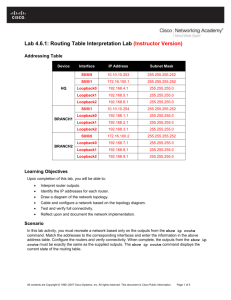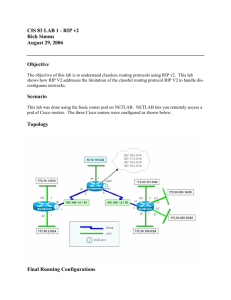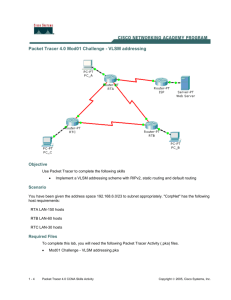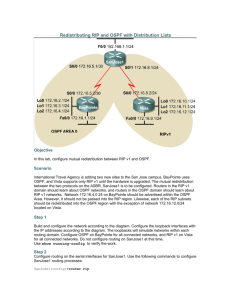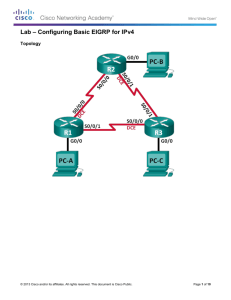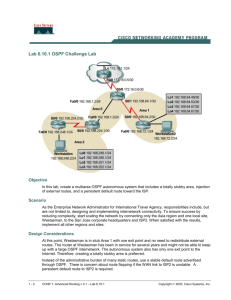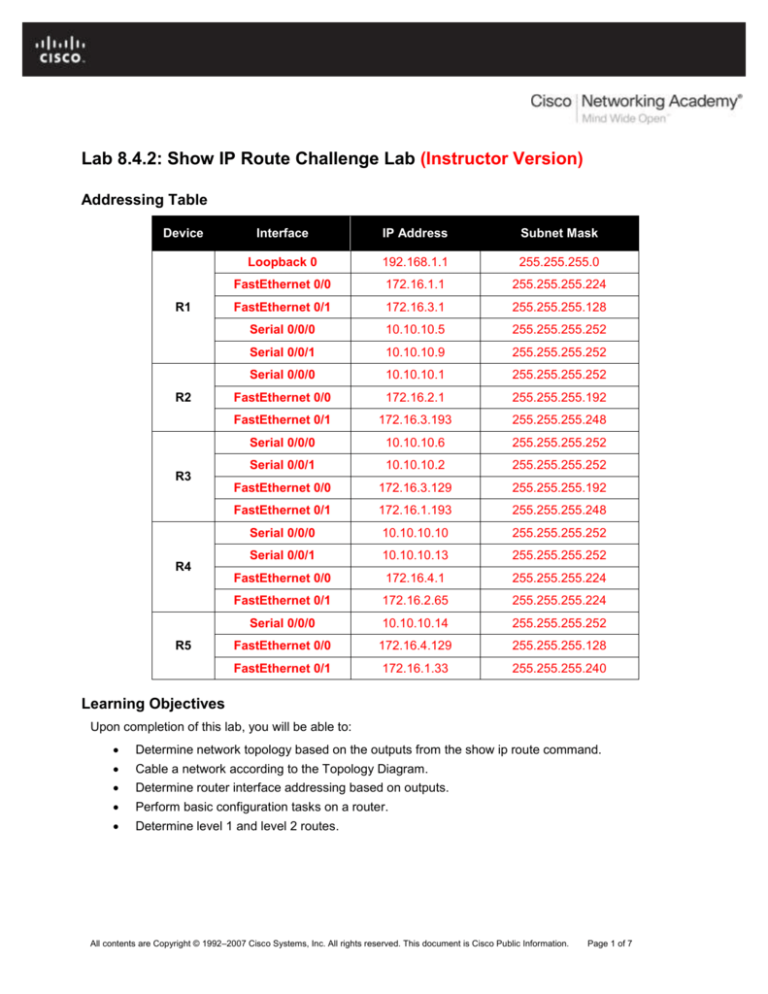
Lab 8.4.2: Show IP Route Challenge Lab (Instructor Version)
Addressing Table
Device
R1
R2
R3
R4
R5
Interface
IP Address
Subnet Mask
Loopback 0
192.168.1.1
255.255.255.0
FastEthernet 0/0
172.16.1.1
255.255.255.224
FastEthernet 0/1
172.16.3.1
255.255.255.128
Serial 0/0/0
10.10.10.5
255.255.255.252
Serial 0/0/1
10.10.10.9
255.255.255.252
Serial 0/0/0
10.10.10.1
255.255.255.252
FastEthernet 0/0
172.16.2.1
255.255.255.192
FastEthernet 0/1
172.16.3.193
255.255.255.248
Serial 0/0/0
10.10.10.6
255.255.255.252
Serial 0/0/1
10.10.10.2
255.255.255.252
FastEthernet 0/0
172.16.3.129
255.255.255.192
FastEthernet 0/1
172.16.1.193
255.255.255.248
Serial 0/0/0
10.10.10.10
255.255.255.252
Serial 0/0/1
10.10.10.13
255.255.255.252
FastEthernet 0/0
172.16.4.1
255.255.255.224
FastEthernet 0/1
172.16.2.65
255.255.255.224
Serial 0/0/0
10.10.10.14
255.255.255.252
FastEthernet 0/0
172.16.4.129
255.255.255.128
FastEthernet 0/1
172.16.1.33
255.255.255.240
Learning Objectives
Upon completion of this lab, you will be able to:
Determine network topology based on the outputs from the show ip route command.
Cable a network according to the Topology Diagram.
Determine router interface addressing based on outputs.
Perform basic configuration tasks on a router.
Determine level 1 and level 2 routes.
All contents are Copyright © 1992–2007 Cisco Systems, Inc. All rights reserved. This document is Cisco Public Information.
Page 1 of 7
CCNA Exploration
Routing Protocols and Concepts:
The Routing Table: A Closer Look
Lab 8.4.2: Show IP Route Challenge Lab
Scenario
In this lab activity, you will determine the topology of a network using the outputs from the show ip route
command. You must draw a topology diagram and determine the interface addressing on each router. Then
you must build and configure the network based on the outputs. The DTE and DCE assignment is at your
discretion. When complete, the outputs from your network must match those given below.
Task 1: Examine the router outputs.
Step 1: Examine the output from the R1 router.
R1#show ip route
Codes: C - connected, S - static, I - IGRP, R - RIP, M - mobile, B – BGP
D - EIGRP, EX - EIGRP external, O - OSPF, IA - OSPF inter area
N1 - OSPF NSSA external type 1, N2 - OSPF NSSA external type 2
E1 - OSPF external type 1, E2 - OSPF external type 2, E – EGP
i - IS-IS, L1 - IS-IS level-1, L2 - IS-IS level-2, ia - IS-IS inter area
* - candidate default, U - per-user static route, o – ODR
P - periodic downloaded static route
Gateway of last resort is not set
R
C
C
R
C
R
R
R
R
C
R
R
R
R
C
S*
10.0.0.0/30 is subnetted, 4 subnets
10.10.10.0 [120/1] via 10.10.10.6, 00:00:09, Serial0/0/0
10.10.10.4 is directly connected, Serial0/0/0
10.10.10.8 is directly connected, Serial0/0/1
10.10.10.12 [120/1] via 10.10.10.10, 00:00:09, Serial0/0/1
172.16.0.0/16 is variably subnetted, 10 subnets, 5 masks
172.16.1.0/27 is directly connected, FastEthernet0/0
172.16.1.32/28 [120/2] via 10.10.10.10, 00:00:09, Serial0/0/1
172.16.1.192/26 [120/1] via 10.10.10.6, 00:00:09, Serial0/0/0
172.16.2.0/26 [120/2] via 10.10.10.6, 00:00:09, Serial0/0/0
172.16.2.64/27 [120/1] via 10.10.10.10, 00:00:09, Serial0/0/1
172.16.3.0/25 is directly connected, FastEthernet0/1
172.16.3.128/26 [120/1] via 10.10.10.6, 00:00:09, Serial0/0/0
172.16.3.192/29 [120/2] via 10.10.10.6, 00:00:09, Serial0/0/0
172.16.4.0/27 [120/1] via 10.10.10.10, 00:00:09, Serial0/0/1
172.16.4.128/25 [120/2] via 10.10.10.10, 00:00:09, Serial0/0/1
192.168.1.0/24 is directly connected, Loopback0
0.0.0.0/0 is directly connected, Loopback0
Step 2: Examine the output from the R2 router.
R2#show ip route
Codes: C - connected, S - static, I - IGRP, R - RIP, M - mobile, B – BGP
D - EIGRP, EX - EIGRP external, O - OSPF, IA - OSPF inter area
N1 - OSPF NSSA external type 1, N2 - OSPF NSSA external type 2
E1 - OSPF external type 1, E2 - OSPF external type 2, E – EGP
i - IS-IS, L1 - IS-IS level-1, L2 - IS-IS level-2, ia - IS-IS inter area
* - candidate default, U - per-user static route, o – ODR
P - periodic downloaded static route
All contents are Copyright © 1992–2007 Cisco Systems, Inc. All rights reserved. This document is Cisco Public Information.
Page 2 of 7
CCNA Exploration
Routing Protocols and Concepts:
The Routing Table: A Closer Look
Lab 8.4.2: Show IP Route Challenge Lab
Gateway of last resort is 10.10.10.2 to network 0.0.0.0
C
R
R
R
R
R
R
C
R
R
R
C
R
R
R
R*
10.0.0.0/30 is subnetted, 4 subnets
10.10.10.0 is directly connected, Serial0/0/0
10.10.10.4 [120/1] via 10.10.10.2, 00:00:04, Serial0/0/0
10.10.10.8 [120/2] via 10.10.10.2, 00:00:04, Serial0/0/0
10.10.10.12 [120/3] via 10.10.10.2, 00:00:04, Serial0/0/0
172.16.0.0/16 is variably subnetted, 10 subnets, 5 masks
172.16.1.0/27 [120/2] via 10.10.10.2, 00:00:04, Serial0/0/0
172.16.1.32/28 [120/4] via 10.10.10.2, 00:00:04, Serial0/0/0
172.16.1.192/26 [120/1] via 10.10.10.2, 00:00:04, Serial0/0/0
172.16.2.0/26 is directly connected, FastEthernet0/0
172.16.2.64/27 [120/3] via 10.10.10.2, 00:00:04, Serial0/0/0
172.16.3.0/25 [120/2] via 10.10.10.2, 00:00:04, Serial0/0/0
172.16.3.128/26 [120/1] via 10.10.10.2, 00:00:04, Serial0/0/0
172.16.3.192/29 is directly connected, FastEthernet0/1
172.16.4.0/27 [120/3] via 10.10.10.2, 00:00:04, Serial0/0/0
172.16.4.128/25 [120/4] via 10.10.10.2, 00:00:04, Serial0/0/0
192.168.1.0/24 [120/2] via 10.10.10.2, 00:00:04, Serial0/0/0
0.0.0.0/0 [120/2] via 10.10.10.2, 00:00:04, Serial0/0/0
Step 3: Examine the output from the R3 router.
R3#show ip route
Codes: C - connected, S - static, I - IGRP, R - RIP, M - mobile, B – BGP
D - EIGRP, EX - EIGRP external, O - OSPF, IA - OSPF inter area
N1 - OSPF NSSA external type 1, N2 - OSPF NSSA external type 2
E1 - OSPF external type 1, E2 - OSPF external type 2, E – EGP
i - IS-IS, L1 - IS-IS level-1, L2 - IS-IS level-2, ia - IS-IS inter area
* - candidate default, U - per-user static route, o – ODR
P - periodic downloaded static route
Gateway of last resort is 10.10.10.5 to network 0.0.0.0
C
C
R
R
R
R
C
R
R
R
C
R
R
R
R
R*
10.0.0.0/30 is subnetted, 4 subnets
10.10.10.0 is directly connected, Serial0/0/1
10.10.10.4 is directly connected, Serial0/0/0
10.10.10.8 [120/1] via 10.10.10.5, 00:00:04, Serial0/0/0
10.10.10.12 [120/2] via 10.10.10.5, 00:00:04, Serial0/0/0
172.16.0.0/16 is variably subnetted, 10 subnets, 5 masks
172.16.1.0/27 [120/1] via 10.10.10.5, 00:00:04, Serial0/0/0
172.16.1.32/28 [120/3] via 10.10.10.5, 00:00:04, Serial0/0/0
172.16.1.192/26 is directly connected, FastEthernet0/1
172.16.2.0/26 [120/1] via 10.10.10.1, 00:00:03, Serial0/0/1
172.16.2.64/27 [120/2] via 10.10.10.5, 00:00:04, Serial0/0/0
172.16.3.0/25 [120/1] via 10.10.10.5, 00:00:04, Serial0/0/0
172.16.3.128/26 is directly connected, FastEthernet0/0
172.16.3.192/29 [120/1] via 10.10.10.1, 00:00:03, Serial0/0/1
172.16.4.0/27 [120/2] via 10.10.10.5, 00:00:04, Serial0/0/0
172.16.4.128/25 [120/3] via 10.10.10.5, 00:00:04, Serial0/0/0
192.168.1.0/24 [120/1] via 10.10.10.5, 00:00:04, Serial0/0/0
0.0.0.0/0 [120/1] via 10.10.10.5, 00:00:04, Serial0/0/0
All contents are Copyright © 1992–2007 Cisco Systems, Inc. All rights reserved. This document is Cisco Public Information.
Page 3 of 7
CCNA Exploration
Routing Protocols and Concepts:
The Routing Table: A Closer Look
Lab 8.4.2: Show IP Route Challenge Lab
Step 4: Examine the output from the R4 router.
R4#show ip route
Codes: C - connected, S - static, I - IGRP, R - RIP, M - mobile, B – BGP
D - EIGRP, EX - EIGRP external, O - OSPF, IA - OSPF inter area
N1 - OSPF NSSA external type 1, N2 - OSPF NSSA external type 2
E1 - OSPF external type 1, E2 - OSPF external type 2, E – EGP
i - IS-IS, L1 - IS-IS level-1, L2 - IS-IS level-2, ia - IS-IS inter area
* - candidate default, U - per-user static route, o – ODR
P - periodic downloaded static route
Gateway of last resort is 10.10.10.9 to network 0.0.0.0
R
R
C
C
R
R
R
R
C
R
R
R
C
R
R
R*
10.0.0.0/30 is subnetted, 4 subnets
10.10.10.0 [120/2] via 10.10.10.9, 00:00:14, Serial0/0/0
10.10.10.4 [120/1] via 10.10.10.9, 00:00:14, Serial0/0/0
10.10.10.8 is directly connected, Serial0/0/0
10.10.10.12 is directly connected, Serial0/0/1
172.16.0.0/16 is variably subnetted, 10 subnets, 5 masks
172.16.1.0/27 [120/1] via 10.10.10.9, 00:00:14, Serial0/0/0
172.16.1.32/28 [120/1] via 10.10.10.14, 00:00:17, Serial0/0/1
172.16.1.192/26 [120/2] via 10.10.10.9, 00:00:14, Serial0/0/0
172.16.2.0/26 [120/3] via 10.10.10.9, 00:00:14, Serial0/0/0
172.16.2.64/27 is directly connected, FastEthernet0/1
172.16.3.0/25 [120/1] via 10.10.10.9, 00:00:14, Serial0/0/0
172.16.3.128/26 [120/2] via 10.10.10.9, 00:00:14, Serial0/0/0
172.16.3.192/29 [120/3] via 10.10.10.9, 00:00:14, Serial0/0/0
172.16.4.0/27 is directly connected, FastEthernet0/0
172.16.4.128/25 [120/1] via 10.10.10.14, 00:00:17, Serial0/0/1
192.168.1.0/24 [120/1] via 10.10.10.9, 00:00:14, Serial0/0/0
0.0.0.0/0 [120/1] via 10.10.10.9, 00:00:14, Serial0/0/0
Step 5: Examine the output from the R5 router.
R5#show ip route
Codes: C - connected, S - static, I - IGRP, R - RIP, M - mobile, B – BGP
D - EIGRP, EX - EIGRP external, O - OSPF, IA - OSPF inter area
N1 - OSPF NSSA external type 1, N2 - OSPF NSSA external type 2
E1 - OSPF external type 1, E2 - OSPF external type 2, E – EGP
i - IS-IS, L1 - IS-IS level-1, L2 - IS-IS level-2, ia - IS-IS inter area
* - candidate default, U - per-user static route, o – ODR
P - periodic downloaded static route
Gateway of last resort is 10.10.10.13 to network 0.0.0.0
All contents are Copyright © 1992–2007 Cisco Systems, Inc. All rights reserved. This document is Cisco Public Information.
Page 4 of 7
CCNA Exploration
Routing Protocols and Concepts:
The Routing Table: A Closer Look
R
R
R
C
R
C
R
R
R
R
R
R
R
C
R
R*
Lab 8.4.2: Show IP Route Challenge Lab
10.0.0.0/30 is subnetted, 4 subnets
10.10.10.0 [120/3] via 10.10.10.13, 00:00:21, Serial0/0/0
10.10.10.4 [120/2] via 10.10.10.13, 00:00:21, Serial0/0/0
10.10.10.8 [120/1] via 10.10.10.13, 00:00:21, Serial0/0/0
10.10.10.12 is directly connected, Serial0/0/0
172.16.0.0/16 is variably subnetted, 10 subnets, 5 masks
172.16.1.0/27 [120/2] via 10.10.10.13, 00:00:21, Serial0/0/0
172.16.1.32/28 is directly connected, FastEthernet0/1
172.16.1.192/26 [120/3] via 10.10.10.13, 00:00:21, Serial0/0/0
172.16.2.0/26 [120/4] via 10.10.10.13, 00:00:21, Serial0/0/0
172.16.2.64/27 [120/1] via 10.10.10.13, 00:00:21, Serial0/0/0
172.16.3.0/25 [120/2] via 10.10.10.13, 00:00:21, Serial0/0/0
172.16.3.128/26 [120/3] via 10.10.10.13, 00:00:21, Serial0/0/0
172.16.3.192/29 [120/4] via 10.10.10.13, 00:00:21, Serial0/0/0
172.16.4.0/27 [120/1] via 10.10.10.13, 00:00:21, Serial0/0/0
172.16.4.128/25 is directly connected, FastEthernet0/0
192.168.1.0/24 [120/2] via 10.10.10.13, 00:00:21, Serial0/0/0
0.0.0.0/0 [120/2] via 10.10.10.13, 00:00:21, Serial0/0/0
Task 2: Create a diagram of the network based on the router outputs.
Step 1: Draw a diagram of the network based on your interpretation of the router outputs in the space
provided below.
Step 2: Document the interface addresses in the Addressing Table.
All contents are Copyright © 1992–2007 Cisco Systems, Inc. All rights reserved. This document is Cisco Public Information.
Page 5 of 7
CCNA Exploration
Routing Protocols and Concepts:
The Routing Table: A Closer Look
Lab 8.4.2: Show IP Route Challenge Lab
Task 3: Build and Configure the Diagram using Packet Tracer.
Step 1: Build the topology diagram in Packet Tracer. Use 1841 or 2811 routers.
Step 2: Configure the interfaces with the appropriate IP address and subnet mask.
Step 3: Configure the appropriate routing protocol for each router and advertise all directly connected
networks.
Step 4: Verify that configurations match the router outputs from Task 1.
Task 4: Identify Routing Processes.
Step 1: Examine the R1 routing table.
What are the IP addresses of the directly connected neighbors of the R1 router?
_____10.10.10.4__________
_____10.10.10.8__________
_____172.16.1.0/27_______
_____172.16.3.0/25_______
_____192.168.1.0/24______
Which routes did R1 learn from the directly connected neighbors?
_____10.10.10.0_________
_____10.10.10.12________
_____172.16.1.32/28______
_____172.16.1.192/26_____
_____172.16.2.0/26_______
_____172.16.2.64/27______
_____172.16.3.128/26_____
_____172.16.3.192/29_____
_____172.16.4.0/27_______
_____172.16.4.128/25_____
Step 2: Examine the R2 routing table.
How many total networks/subnets did R2 learn from its neighbors?
_____13_____
Where would R2 send packets to networks not currently in its routing table? Why?
______________________________________________________________________________________
_______________________________________________________________________________________
The packets would be sent to the R3 router at the IP address 10.10.10.2. This is the IP address that is the
default route in the R2 routing table.
What does the statement “ R* 0.0.0.0/0 [120/2] via 10.10.10.2, 00:00:04, Serial0/0/0” at the end of the R2
routing table represent?
_____Default route to 10.10.10.2___________________________________
All contents are Copyright © 1992–2007 Cisco Systems, Inc. All rights reserved. This document is Cisco Public Information.
Page 6 of 7
CCNA Exploration
Routing Protocols and Concepts:
The Routing Table: A Closer Look
Lab 8.4.2: Show IP Route Challenge Lab
Step 3: Examine the R3 routing table.
Which Level 2 routes did R3 learn about from its neighbors?
_____10.10.10.8________
_____10.10.10.12_______
_____172.16.1.0/27______
_____172.16.1.32/28_____
_____172.16.2.0/26______
_____172.16.2.64/27_____
_____172.16.3.0/25______
_____172.16.3.192/29____
_____172.16.4.0/27______
_____172.16.4.128/25____
_____192.168.1.0/24_____
Which networks are directly connect to R3?
_____10.10.10.0__________
_____10.10.10.4__________
_____172.16.1.192/26_____
_____172.16.3.128/26_____
Step 4: Examine the R4 routing table.
Which network is the furthest distance from R4 and how many hops away is it?
_____________________________________________________________
The 172.16.2.0/26 network is 3 hops away.
How many usable host addresses are on the network furthest from R4? _____62_____
Step 5: Examine the R5 routing table.
How many routers must a packet pass through to get from R5 to network 172.16.2.0/26? _____4_____
Why is the “Gateway of last resort” for R5 listed as 10.10.10.13?
_____________________________________________________________
It is the next hop address on the way to the Gateway of Last Resort.
All contents are Copyright © 1992–2007 Cisco Systems, Inc. All rights reserved. This document is Cisco Public Information.
Page 7 of 7

